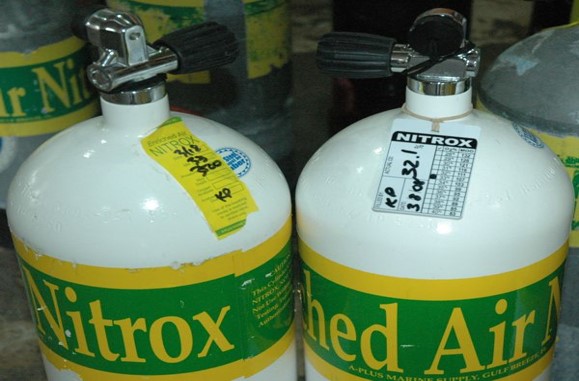Nitrox Diving Explained

Nitrox Diving Explained
Diving with nitrox is increasingly
widespread nowadays. This article will explain what nitrox is and why you
should use it.
The oxygen that we all breathe is one of
the most common elements in the universe and is vital for life. The mixes used
in recreational diving have higher oxygen concentrations, such as Nitrox.
Nitrox
The normal air that we breathe contains 21%
oxygen with the rest 79% being nitrogen (not including the 1% other gases).
Nitrox (also called EANx or Enriched Air Nitrox) has a higher oxygen
concentration – between 21 and 40%. This gas has been used for a long time:
from the Navy, diving companies etc. Now it is widely recognized as the
preferable gas mixture for recreational diving, especially for diving in depth
between 18 and 40 meters, where its effectiveness is the highest.
Why Nitrox?
The main advantage of using Nitrox is that
is the extended bottom time – the time you can spend at a certain depth before
having to make a decompression stop.
The key factor when achieving this time is
the amount of nitrogen you have taken in your organism while being under
pressure.
When using a standard PADI / DSAT diving
table, diving at 21 m (70 feet) will require a decompression stop after 40 minutes
(given no previous dives).
By replacing a portion of the nitrogen in your
dive tank and increasing the total oxygen concertation in the bottle to 32%,
you can extend the time without decompression stopping up to 60 minutes.
However, that doesn’t mean that all your
dives will last longer. The duration of the dive also depends on your personal
gas consumption (SAC rate), the diving depth, the temperature of the water, boat
rules etc.
Another misconception is that Nitrox allows
diving at greater depth. If you over-expose to oxygen -because of exceeded
depth or time limit – this can lead to serious complications.
Advantages
of diving with Nitrox:
·
Longer bottom times by
no-decompression diving
·
Shorter decompression times
·
Shorter surface intervals
·
Decrease of residual nitrogen
in the body after the descent
·
Reduced likelihood of
decompression sickness
·
Decreased probability of nitrogen
narcosis
Are there
any dangers?
You should know what exactly is in your
tank, analyze it personally, and plan your dive carefully, before Nitrox diving.
The use of the wrong mixture or cylinder can be very dangerous. The different
percentage mixtures have different maximum operating depth (MOD), which you
should take into account when choosing your mixture according to the dive you
are about to do.
WARNING
Do not use nitrox without a preliminary gas
analysis
Do not use nitrox with more than 40% oxygen
if you are not certified for this
Sometimes there are several tanks with different mixtures on the diving boat, depending on the personal specifications of the divers and the requirements of the site. Thus, mistakes can easily happen and the consequences might be fatal. You can avoid that by correctly labeling your dive tank.
Labeling of the cylinder
The nitrox cylinders must be labeled with the usual green and yellow EANX/Nitrox labels. However, this is not always the case and sometimes there is no marking on the tanks. It is important that you mark your dive tank with the appropriate label to avoid any mistakes!
The labeling of diving tanks must include:
The label describing the percentage of oxygen
Label with color code and"NITROX"
Label with the maximum working depth
Warning label: "Caution! Breathingmedia other than air "
Label for marking the gas analysis results immediately before descending


Leave your comment
Note: HTML is not translated!